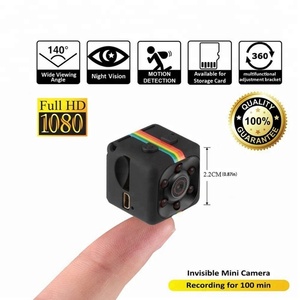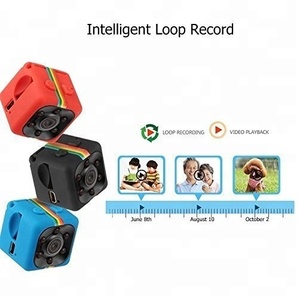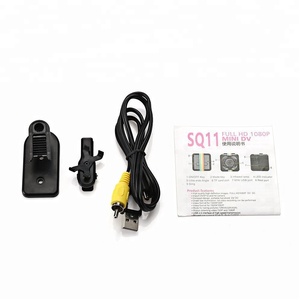(183 products available)
























































































































































































































Tiny DVRs come in various forms and are suitable for different applications. Here are the common types:
Handheld or Portable DVR
Handheld or portable tiny digital video recorders are designed for convenience and portability. They are very lightweight and have compact designs. Some portable tiny DVRs can even fit in pockets. Users can carry these tiny DVRs anywhere, making them ideal for recording on the go. These portable tiny DVRs are ideal for personal use, like recording lectures and meetings. They are also useful for outdoor activities like hiking and biking. Portable tiny DVRs usually have rechargeable batteries that last for several hours. They also have bright displays that allow users to view recorded content.
Security DVR
Security DVRs are designed for surveillance and security applications. They record and store CCTV footage. These tiny DVRs allow users to monitor their homes and businesses. Security DVRs, especially those with wireless capabilities, are easy to install. Users can mount these tiny DVRs in many locations. Some security DVRs come with several channels for connecting multiple cameras. They also have features like motion detection, enabling them to start recording after sensing movements.
Car DVR
Car DVRs, also known as dash cams, are designed to record the road ahead or behind while driving. They enhance driving safety by recording incidents, providing evidence in case of accidents. Some car DVRs have GPS modules that show the speed and location while recording. They also have G sensors that automatically save recordings during impacts. Car DVRs have loop recording features that ensure the camera always has recording space by overwriting the oldest footage.
Body-Worn Camera DVR
Body-worn camera DVRs are designed to be worn on the body or attached to clothing. They are used for recording video in various contexts, such as law enforcement, healthcare, and research. These tiny DVRs can record interactions, events, and incidents. Body-worn camera DVRs improve accountability and transparency. They also enhance safety by providing a recorded backup in case of emergencies. Some body-worn camera DVRs have streaming capabilities so users can monitor activities remotely. They also have encryption features to protect the recorded data.
Wireless DVR
Wireless tiny DVRs use wireless technology like Wi-Fi or Bluetooth to connect to other devices. They allow remote access and control. Users can stream the recorded footage on smartphones or tablets. Wireless tiny DVRs are convenient because they eliminate the need for connecting cables.
Specifications for any Tiny DVR camera are essential for understanding customers' needs. Here are some standard specifications for tiny DVRs:
Tiny DVR maintenance is essential for longevity and optimal performance. Here are some maintenance tips for tiny DVRs:
Choosing the right tiny DVR requires consideration of various factors to ensure that the needs of the end users are met. Here are some of the factors to consider:
Purpose
When choosing a tiny DVR, the intended use or purpose for the device should be considered. For instance, if it is going to be used for car surveillance, then a tiny DVR for cars should be chosen. This is because tiny DVRs for cars are designed to withstand extreme temperatures that are experienced during summer in some regions. Also, their design is suited for the purpose of recording videos while driving.
Storage Capacity
The storage capacity of the tiny DVR should be considered. Users with higher storage needs should go for DVRs with larger internal storage. Also, tiny DVRs that support external storage through SD cards should be considered.
Video Quality
The video quality of the tiny DVR should be considered. Higher resolutions such as 4K offer better quality, while lower resolutions such as 720p offer lower quality.
Power Supply
The power supply of the tiny DVR should be considered. For portable and handheld devices, tiny DVRs with internal batteries or those that are rechargeable should be chosen. Meanwhile, for stationary or fixed placements, such as on a car's dashboard, tiny DVRs should be chosen that have constant power supply from wall outlets or through USB ports.
Camera Compatibility
If external cameras are to be connected to the tiny DVR, then the compatibility of the DVR with various cameras should be considered. This includes checking for the number of cameras that can be supported and whether the tiny DVR has the necessary ports.
Features
Extra features such as GPS, G-sensor for impact detection, Wi-Fi connectivity, and loop recording should be considered. These features add more functionality to the tiny DVR and can be useful.
Budget
Another important thing that should be considered is the budget of the tiny DVR. Setting up a budget helps to narrow down the options to those that are affordable. It is also important to consider the value for money. This is because the most expensive tiny DVR may not necessarily be the best for every use case.
Brand Reputation
The brand reputation of the tiny DVR should be considered. Brands that are well known for quality products and good customer support should be chosen. This ensures that quality products are received and any issues that arise can be addressed.
Ease of Use
Lastly, the ease of use of the tiny DVR should be considered. Features such as user-friendly interfaces, easy installation, and setup should be considered. Also, tiny DVRs with clear displays and controls should be chosen for ease of use.
Replacing a tiny DVR camera can be a straightforward process. Below are the steps to take:
Access the device:
To replace the DVR, users will first access the device. This involves removing the device from its installed location. Whether it's mounted on a wall, placed on a shelf, or installed elsewhere, gently detach it without damaging the surrounding area or other components.
Disconnect the cables:
Once the tiny DVR camera is accessible, the next step is to disconnect all the connected cables. This includes power cables, HDMI or VGA cables (for video output), and any audio cables. Take note of how these cables are connected for easy reconnection.
Remove mounting hardware:
After disconnecting the cables, users will remove any mounting hardware that holds the tiny DVR in place. This may include screws, brackets, adhesive pads, or other mounting components. Keep these hardware pieces in a safe place to facilitate the installation of the new DVR.
Disconnect peripheral devices:
At this point, users will disconnect any peripheral devices connected to the tiny DVR. This may include external hard drives, USB flash drives, or network cables (for internet connectivity). Disconnecting these devices ensures a smooth replacement process and prevents data loss or network interruption.
Uninstall software integration:
If the tiny DVR was integrated with specific software applications or security systems, users would uninstall or disconnect the software integration at this point. Follow the manufacturer's instructions or consult relevant documentation to remove the software integration safely.
Replace the tiny DVR camera:
Now, it's time to install the new tiny DVR camera. Take the new device and prepare it by connecting the necessary cables (power, video output, audio) according to the manufacturer's instructions. Ensure a secure and snug fit to prevent any signal loss or interruptions.
Reconnect peripheral devices:
Once the new DVR is installed and powered on, users will reconnect any peripheral devices previously disconnected. This includes external hard drives, USB flash drives, and network cables for internet connectivity. Ensure secure connections to facilitate data transfer and network communication.
Reinstall mounting hardware:
After installing the new tiny DVR and reconnecting peripheral devices, reinstall any mounting hardware removed during the process. Secure the device in its installed location using screws, brackets, adhesive pads, or other mounting components. Ensure proper alignment and stability to prevent future falls or damage.
Reconnect cables:
Now that the new tiny DVR is installed and mounted, users will reconnect all the disconnected cables. This includes power cables, video output cables (HDMI or VGA), and audio cables. Refer to the notes taken during disconnection to ensure accurate connections.
Power on and test:
Before finalizing the replacement process, users will power on the new tiny DVR and test its functionality. Ensure that video and audio signals are working correctly, and perform tests to verify that all features and functionalities are operational. Troubleshoot any issues that may arise during the installation process.
Q1: How long does the battery of a tiny DVR last?
A1: The battery life of a tiny DVR depends on several factors, including the tiny DVR's storage capacity, the number of channels, the video quality, and the encoding methods. Generally, a tiny portable DVR with a 2000 mAh battery can last for 8 to 10 hours, while those with a 5000 mAh battery can last for 18 to 20 hours. Some have a removable battery that can last for 30 hours or more. Users can adjust the settings to optimize their tiny DVR's battery life.
Q2: Can users access a tiny mobile DVR remotely?
A2: Yes. Users can access their tiny mobile DVR remotely. They can connect their tiny mobile DVR to a local network through an Ethernet port or a Wi-Fi adapter. Then, install the remote access application on their mobile phone or computer. Create an account and bind the tiny mobile DVR to the account. After remote access is enabled, users can access their tiny mobile DVR remotely through their mobile phones or computers.
Q3: Can users connect a tiny DVR to any monitor?
A3: Yes. Users can connect a tiny DVR to any monitor that has compatible connection ports. These ports include HDMI, VGA, DVI, and Audio. They only need to use the correct cable or adapter to connect the tiny DVR to the monitor. If the monitor has different ports from those available on the tiny DVR, they can use an adapter to create a connection.
Q4: Can a tiny DVR record audio?
A4: Yes. A tiny DVR can record audio. It has audio input ports that allow users to connect external microphones to enhance audio recording. Some advanced tiny DVRs also have built-in microphones to record audio from the surrounding environment.
Q5: Can users upgrade their tiny DVR's firmware?
A5: Yes. Users can upgrade their tiny DVR's firmware. They need to visit the manufacturer's official website to get the latest firmware version. Then, follow the manufacturer's instructions to perform the firmware upgrade. A firmware upgrade improves the tiny DVR's performance by adding new features, fixing bugs, and enhancing compatibility.
The keyword "tiny dvr" maintains a stable web search volume trend with an average of 10 monthly web searches. Over the past year, there has been no significant change in web search volume, evidenced by a 0% one-year change and consistent monthly figures. This stability is further supported by a flat three-month change and a steady pattern of web search volumes across the 12-month data provided.
Analyzing the web search volume data for "tiny dvr," we observe a consistent pattern where the keyword receives 10 web searches for most months, with notable absences in December 2023 and June 2024, where web searches dropped to zero. This pattern suggests a certain level of periodic interest or perhaps seasonal influences affecting search behavior. Despite these brief interruptions, the keyword quickly recovers its usual web search volume, indicating a sustained but niche interest in this product category.
The reasons behind the observed trends for "tiny dvr" could be multifaceted. The consistent web search volume might suggest a steady but small consumer base looking for this specific product, possibly driven by niche market needs or specific use cases not covered by mainstream security solutions. The zero search months could be attributed to factors such as holiday seasons affecting consumer behavior or external market events impacting interest in security products. However, without additional context, the exact reasons for these trends remain speculative.